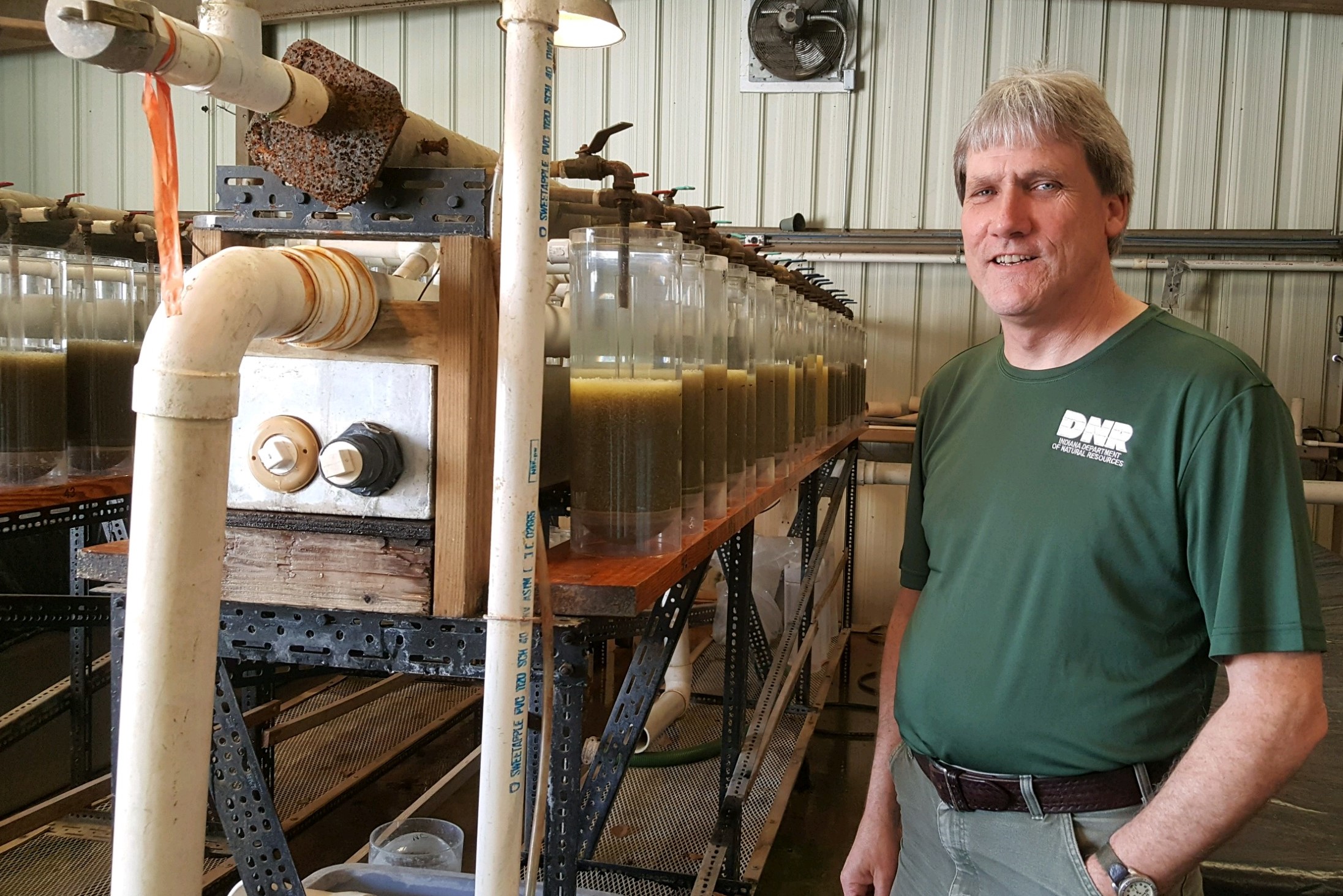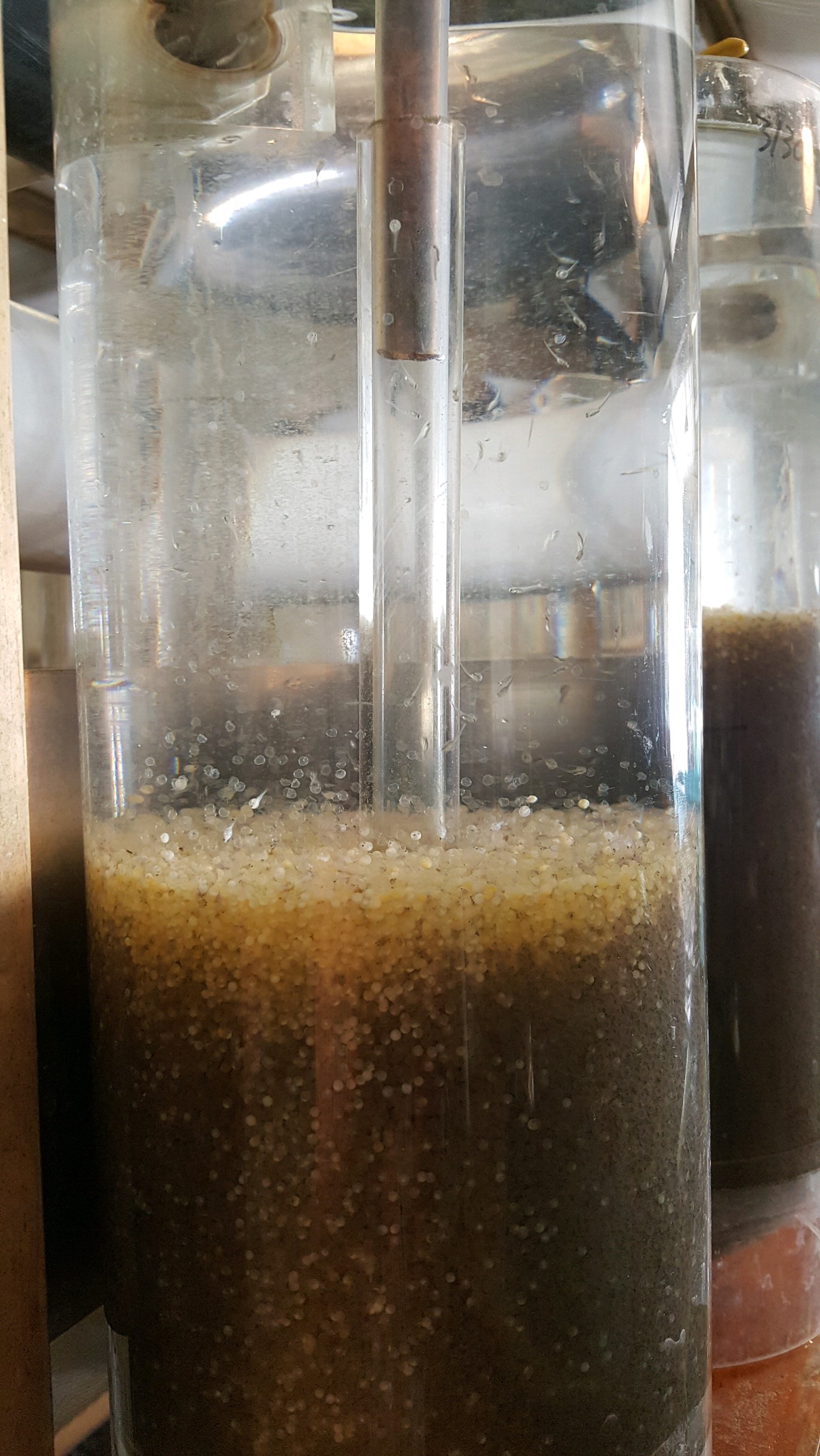This story was published May, 2018.
Story and photos by Brent Brown, INSPD Communications
Plenty of Fish In The Lakes

Hoosiers who gleefully hang "gone fishing" signs as they depart before dawn for their favorite trawling spots likely owe a debt of gratitude to people like Jeff Malwitz.
Property manager of the Cikana State Fish Hatchery near Martinsville, Malwitz and his small crew operate a facility that annually stocks Indiana waterways with more than 20 million freshwater fish. In 2017 alone, Cikana stocked just short of 23 million of the scaly swimmers -- a total that includes walleye, channel catfish, bluegill and black crappie.
It’s an intricate, often delicate year-round process where success hinges on a harmonious relationship among nature, nurture and fortune’s ever-changing whims.
With so many factors involved – weather, natural predators, and food availability among them -- only a relative handful of the millions of harvested walleye eggs will survive to adulthood, thriving in places such as Brookville Lake, Lake Monroe and Patoka Lake.
The story is much the same for the catfish population, which involves a process distinct in many ways from the walleye stocking program that has occupied the hatchery’s crew this spring.
To be sure, fish stocking is important work that impacts the environment as much as it assists those with a penchant for piscary.
As anyone who has spent time by the river, fishing pole in hand, will likely attest, there’s no substitute
for natural bodies of water, sunshine and an ample amount of aquatic life ripe for the catch. The process at Cikana is in place to keep up the water’s end of that unstated bargain. After all, the only thing more disappointing to a fisherman than missing out on a big catch is not having anything to catch at all.
At the same time, they’re working to mimic Mother Nature as closely as possible, giving her a bit of a boost by helping along our finned friends’ spawning process. The result has been a healthy population of fish who otherwise wouldn’t find their way into some of Indiana’s most pristine waters – and prime fishing locations.
Fish Tale
Malwitz is no novice when it comes to the process at Cikana.
The Michigan native has spent the better part of the last three and a half decades in various positions at the Morgan County warm-water hatchery, which operates alongside similar facilities spread among six districts throughout the state. The process is performed under the auspices of the Indiana Department of Natural Resources, and the hatcheries coordinate their operations with one another in order to produce an adequate number of fish statewide.
Shortly after earning his fisheries biology degree from Michigan State University in 1982, Malwitz began his career as a grass cutter on the same grounds he manages today.
Even doing that seemingly unrelated work, he knew right away that Cikana was just the place for him. He was all-in on his new career – hook, line and sinker.
"It was a chance to come in and get my hands dirty, and that’s all it took for me to know exactly what I wanted to do," Malwitz recalled.
Time hasn’t dimmed the hatchery manager’s enthusiasm for his job, either. He described his colleagues as "like family" and discussed the Cikana process with a combination of reverence and reserved pride.
On a warm April day, he provided a guided tour of the hatchery on the facility’s East Unit, a 78-acre location with 22 earthen ponds. The North Unit features an additional 13 ponds on 40 acres.
On that particular morning, the East Unit was also "home" to about 38 million walleye eggs recently harvested from several hundred females preparing to spawn. In eight days, the Cikana crew caught about 2,300 female walleye; however, only about a quarter of those were ready to release the entirety of their eggs. That means some of the eggs were closer to hatching than others. Nonetheless, the total could bode well for this year’s population.
Packed to the Gills
Housed in well water-filled incubation tubes, some of the millions of tiny eggs had already sprouted tails and were swimming upward in the tubes, apparently determined to get to the next step on a journey not every newly-hatched critter will complete. A larger basin filled with the same water and kept at an identical 54 degree temperature held even more of the erstwhile eggs, which swam toward a light, mimicking their natural activities and increasing their resilience and swimming capability.
And that’s the goal.
"Basically, we just kind of help them along on a natural process," Malwitz said.
But there are some parts of nature that simply don’t work in a controlled environment.
Malwitz explained that walleye eggs naturally stick together, which doesn’t help their chances of hatching in the incubation tubes, so they’re coated with a substance that helps keep them separated.
"It’s a little bit like rolling gum in dirt," he said with a chuckle.
As the fish develop, they are further treated, thereby increasing each "pickerel’s" (as the walleye is often called in Canada) chances in nature.
 This year’s "crop" of walleye eggs was a tad ahead of the annual goal of approximately 35 million, though Malwitz said only around 70 percent of the eggs will hatch into fry.
This year’s "crop" of walleye eggs was a tad ahead of the annual goal of approximately 35 million, though Malwitz said only around 70 percent of the eggs will hatch into fry.
Fry, in some walleye-adoring circles, are described as little more than "two eyes ‘n a wiggle." Though diminutive, many of the tadpole-like fry prove hardy enough to end up in one of the three aforementioned Hoosier lakes where they can go about their simple business of being a fish – just as though their newfound swimming space had been their home all along.
A smattering of others grow into fingerlings – baby fish that measure about 1 to 2 inches in length – in ponds at four separate hatcheries before arriving at larger waterways. Fingerlings end up in places like Lake Shafer (Monticello), Eagle Creek Reservoir (Indianapolis), and Lake of the Woods (Bremen).
The fry and fingerlings that make it to their destinations, with a little bit of luck, will grow into adulthood.
And getting to those zooplankton-filled waters really is a matter of necessity. There is no food source in the incubation tubes or tanks at Cikana, so the newborn fish must take up residence in lakes, rivers and streams in order to find food and survive. It’s the job of the Cikana crew to give them the best chance of getting there.
Malwitz and his colleagues pack up the Lilliputian walleye into oxygen-filled bags of water, similar to how a goldfish purchased at a pet store is kept until it can be safely deposited in a home aquarium, and head out to the lakes on boats. The fish – 100,000 strong per bag -- are then set free. The rest is up to nature.
‘A Really Great Career’
It’s a continuing cycle that Malwitz still finds plenty of enjoyment in aiding.
The grounds of Cikana are constantly abuzz with activity as each spring brings the harvesting of walleye eggs followed by the monitoring of the on-site catfish population in the warmer months. Colder temperatures leave time for maintenance and facility upkeep.
Malwitz joked that he has learned many facets of being a plumber
and an electrician throughout his long career and, of course, the property manager has plenty of paperwork to prepare on a daily basis. Those are perhaps the less glamorous parts of the job, and although he’s keenly aware of the necessity of all that, Jeff Malwitz still would rather be outdoors.
"That’s important stuff that needs to be done, but I’d just as soon be outside doing something," Malwitz said with a smile. "A lot of people would feel that same way, I’m sure."
On one sun-bathed April morning, Malwitz walked the fish hatchery grounds, detailing how the disparate facilities spread throughout the state work so closely together – and how important that is to their mission. Taken as a whole, the hatcheries stock a total of 16 different fish species, according to the Indiana DNR.
State fishery biologists are also part of the team, examining the waters to help keep healthy fish populations in each. The hatchery managers then adjust their plans accordingly, helping one another whenever possible.
The biggest beneficiaries of the never-ending process are those who spend summers on the lake, dreaming of catching "the big one," making new memories each season with family and friends.
A portion of proceeds from fishing licenses helps fund the hatcheries, as well as Hoosier wildlife conservation as a whole, but if the anglers enjoying their time outside each year never once stop to think of the elaborate process behind filling the lakes with aquatic game, Malwitz is more than okay with that.
He does what he does because he loves nature, and his work has a direct impact on the health of Indiana waters – and many of the creatures living therein.
"We wouldn’t put in all this effort for something that we didn’t feel wasn’t going to work – wasn’t worth it," Malwitz said. "You have to be passionate about what you do."
The property manager also praised his team, which includes Assistant Property Manager Andy Richards, Hatchery Biologist Kyle Robertson and Equipment Operator Tom Arthur.
Looking across one of the ponds on the grounds of the East Unit of the hatchery, he reflected on his work at Cikana, that passion for his job palpable in his voice.
"It’s just been wonderful," he said smiling. "I’ve just had a really great career."